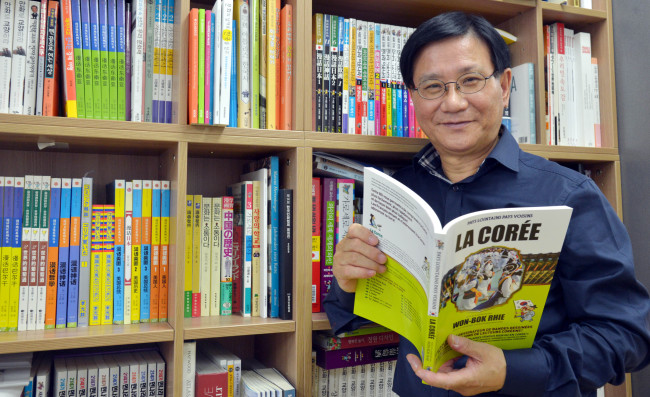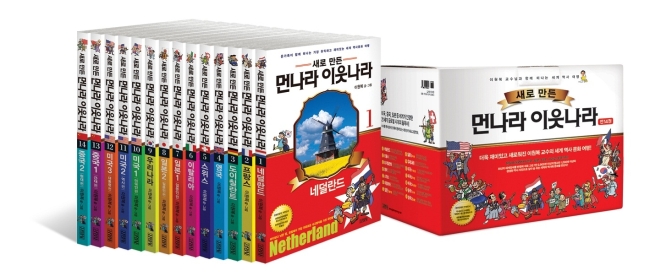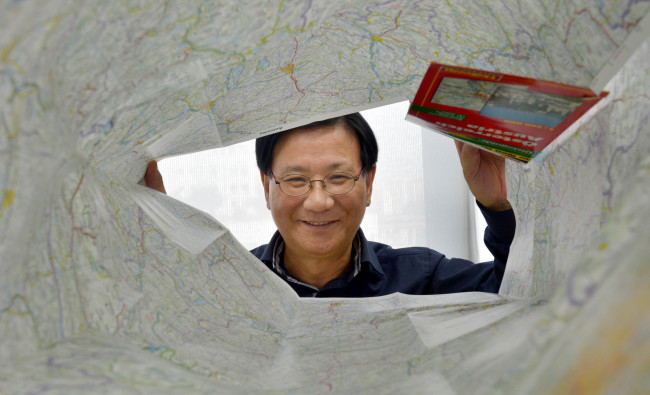From doodler to iconic cartoonist
Comic book author reminisces on 50 years of illustrations
By Claire LeePublished : Sept. 27, 2013 - 21:51

As a kid, cartoonist and scholar Rhie Won-bok spent most of his time doodling alone.
“In the 1950s, you only had two choices as a kid,” Rhie, now 66, tells The Korea Herald. “You either went outside and played with other kids, or stayed inside and found something to do. People were poor and we all didn’t have many things. Books were also very hard to find. I wasn’t a very active type, so I stayed inside and just doodled.”
After many years of doodling, he started drawing random things. He drew a lot of cowboys. At the time, Rhie had no idea he would spend his entire life creating cartoons.
“I saw the cowboys in movies,” he says. “Movies were pretty much the only visual entertainment available.”
Rhie is, without a doubt, a cartoonist with a unique career. For one, he is the creator of one of the most enduring and successful manhwa series in the country.


His educational cartoon series, “Far Countries, Near Countries” featuring the inner workings and culture of foreign nations, has sold over 17 million copies in the past 33 years.
He finished the series’ last volume, which features Spain, in March. The first volume came out in 1981. The series features Korea, Japan, China, the U.K., the U.S., Germany, France, Italy and the Netherlands, among others.
“This is the end of the series, not my career,” says Rhie, who has been drawing cartoons for almost half a century. “So I’m not overwhelmed with emotions about it. I feel calm.”
For 29-year-old office worker Kang Soo-hyun, Rhie’s “Far Countries, Near Countries” was the only comic book she was allowed by read as a child.
“My mother didn’t think comic books were good for me,” she recalls.
“So I wasn’t allowed to read them in the house. But her only exception was ‘Far Countries, Near Countries.’ She thought the series was good for me even though it was a cartoon. She certainly wanted me to learn about other countries and their history, and there were no other children’s books that were as entertaining and informative as the series.”
The edition on Korea and its culture was translated into English and published under the title “Korea Unmasked” in 2002. The volume will be translated into six other languages ― French, Chinese, Spanish, German, Russian and Indonesian ― and will be published overseas throughout this year.
Although he now enjoys his success, Rhie was never too serious about being a cartoonist until he went to Germany to study in his 20s. At Seoul National University, his major was architecture, which, in Rhie’s words, was “never my cup of tea.”
He seldom went to his classes, and instead spent most of his time in his dorm room, drawing cartoons for Sonyeon Hankook Ilbo ― a newspaper for children and teenagers ― as his part time job. The best part was the monthly pay day. “I’d use the money to buy drinks for my friends,” Rhie says, with an almost impish smile. “It was so much fun. I’m pretty sure I bought drinks for everyone in the program.”

Yet moving to Germany changed his life. “I went into a bookstore and was stunned to discover a huge section dedicated exclusively to comic books,” he says. “I’d never seen anything like that before and thought perhaps Korea’s cartoon industry will soon grow into something like this. It was in Germany that I decided to become a full-time cartoonist.”
He enrolled in a design program at the University of Munster. One of the school assignments he remembers is one where he and his classmates were asked to draw “horror.”
“I was rather puzzled by the assignment,” Rhie says. “I mean, how do you really draw ‘horror’? I drew a Dracula and submitted it. But I was really surprised to look at the works of my classmates. One of them drew something very similar to Edvard Munch’s ‘The Scream.’ There were so many different interpretations of what horror is.”
What fascinated Rhie the most was Germany’s diversity. “Germany shares borders with nine different countries,” says Rhie. “So the concept of what is ‘global’ or ‘diverse’ wasn’t anything new in Germany. But it was new in Korea when the first series came out. It was something that people were interested in reading about.”
Inspired by what he saw and learned in Europe, he started “Far Countries, Near Countries” while living in Germany as a student and traveled extensively while creating the series. It first appeared as a series in Sonyeon Hankook Ilbo. With no Internet at the time, he had to mail his work to Korea each time. Throughout his career, Rhie never missed a single deadline.
“I made the deadline even when I was drunk during college,” Rhie says. “That’s called professionalism.”
As a child, Rhie lived through an era of postwar poverty. It was very difficult to meet someone who have had lived or visited overseas. One time, his classmate’s father visited the U.S. and it was a huge deal in his class. “It was hard to even imagine what it was like overseas,” he says. “We all just had no idea.”
Rhie says he grew up with “ultimate freedom.” His mother died when he was 10, his father when he was 20. He was the youngest among seven children.
“Everyone in my family was busy making ends meet,” Rhie says. “So they just left me alone. I always got to make my life decisions on my own. It’s not something kids these days get to do. I was lucky.”
Even now, Rhie says he enjoys being alone. He loves drawing cartoons, drinking with a small group of people, reading and even playing computer games. The cartoonist calls alcohol his “only religion” and says that throughout his career, he has never gotten sick of his job. He calls himself a “very lazy person” and says he’s never exercised in his life. “I take a car even when I go to a mall across from my house,” he says. And anyone would agree that he looks young for his age.

“Drawing cartoons means you are living in the fantasy,” Rhie says. “It lets you visualize what you dream. All you need are a pen and paper. It doesn’t take money to do whatever you want with your characters. That is why it is never boring. You are free when you are drawing cartoons. You never get sick of it.”
The cartoonist, who also teaches design at Duksung Women’s University, says he would’ve ended up owning a small interior goods shop if he had not drawn cartoons. “Most of my classmates in architecture school went to the Middle East after graduation, as construction managers,” he says. “I’m not particularly a social person with people skills, so I don’t think I would’ve gone.”
Rhie, who is still working on his upcoming books about world history, says he only works about two or three hours a day on his cartoons. He is a firm believer in “quality over quantity.”
Being a professor at a university, he says he often feels bad for the younger generations of artists. “Although my generation experienced poverty, we had a lot of opportunities,” he says. “Everything was pretty much a blue ocean. But now pretty much everything has been explored and crowded with competitors. Class mobility is much more difficult nowadays.”
And his advice? Study the humanities.
“The world is constantly changing now,” he says. “And you have to read those changes and trends. And in order to understand the changes, you have to understand the way we live. And that’s what humanities is all about.”
By Claire Lee (dyc@heraldcorp.com)



![[Exclusive] Korean military set to ban iPhones over 'security' concerns](http://res.heraldm.com/phpwas/restmb_idxmake.php?idx=644&simg=/content/image/2024/04/23/20240423050599_0.jpg&u=20240423183955)
![[AtoZ into Korean mind] Humor in Korea: Navigating the line between what's funny and not](http://res.heraldm.com/phpwas/restmb_idxmake.php?idx=644&simg=/content/image/2024/04/22/20240422050642_0.jpg&u=)



![[Graphic News] 77% of young Koreans still financially dependent](http://res.heraldm.com/phpwas/restmb_idxmake.php?idx=644&simg=/content/image/2024/04/22/20240422050762_0.gif&u=)
![[Herald Interview] Why Toss invited hackers to penetrate its system](http://res.heraldm.com/phpwas/restmb_idxmake.php?idx=644&simg=/content/image/2024/04/22/20240422050569_0.jpg&u=20240422150649)





![[Exclusive] Korean military to ban iPhones over security issues](http://res.heraldm.com/phpwas/restmb_idxmake.php?idx=652&simg=/content/image/2024/04/23/20240423050599_0.jpg&u=20240423183955)



![[Today’s K-pop] Ateez confirms US tour details](http://res.heraldm.com/phpwas/restmb_idxmake.php?idx=642&simg=/content/image/2024/04/23/20240423050700_0.jpg&u=)